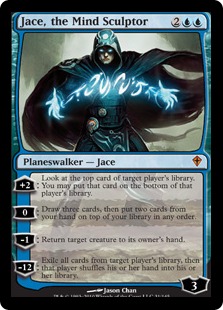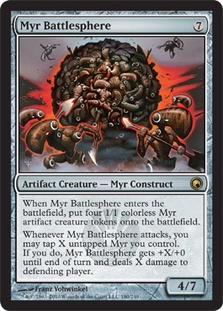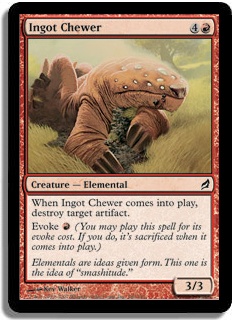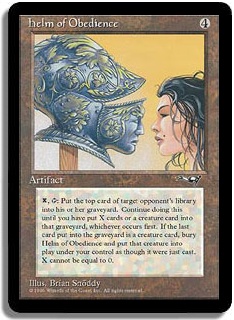It’s been quite a while since I’ve written anything about Magic. This is mainly due to me playing a lot less actual Magic lately. This has been for a whole bunch of reasons, but I think the catalyst was the end of year MOCS tournament. Magic Online, and all of Wizards’ websites, stopped allowing me access to them on my or any other computer for long enough for me to get dropped at 2-0. Needless to say, I was pretty angry. I liked my deck, I had spent ages tuning it, and I had woken up at a most unpleasant time to play in the tournament. And since I had paid no entry fee for the event, I was not entitled to any compensation.
Unhappy rant aside, I want to talk about the Magic that I have played this year. I made the Top 8 of Grand Prix Sydney (winning out from 4-2). But it was a Limited GP, and my understanding is that people are not really that interested in my thoughts on that kind of Magic. That and the format was Return to Ravnica Limited, so it wouldn’t be all that relevant at this point in time anyway.
The week following the GP, there was an event called Cancon. Cancon is a massive annual convention held in Canberra. They were offering a Vintage tournament with a Mox as first prize, a 7-point Highlander (an Australian variant of 60-card Highlander) tournament with a Mox as first prize, a Legacy tournament for a playset of Force of Wills, and a Modern PTQ. In Australia, these are pretty big events, and the fact that they were all occurring in the same place at the same time justified the seven-hour drive from Melbourne each way.
I am going to discuss the changes that I made to my Vintage deck in anticipation of this event as well as the Legacy deck that I wished I’d played.
As many of you may have read in a previous article of mine, I love Vintage. I love its complexity and how challenging it can be. Aloysius, a good friend of mine, is a complete Vintage nut, and given the size of first prize, he was able to convince me to test a whole lot of Vintage in the weeks leading up to the event. This is the list that I played:
Creatures (7)
Planeswalkers (3)
Lands (15)
Spells (35)
- 1 Brainstorm
- 2 Mana Drain
- 2 Lightning Bolt
- 1 Vampiric Tutor
- 1 Mystical Tutor
- 1 Yawgmoth's Will
- 4 Force of Will
- 1 Sol Ring
- 1 Demonic Tutor
- 1 Hurkyl's Recall
- 1 Island
- 1 Time Walk
- 1 Ancestral Recall
- 1 Mana Crypt
- 1 Time Vault
- 1 Gifts Ungiven
- 1 Merchant Scroll
- 1 Rack and Ruin
- 1 Tinker
- 1 Voltaic Key
- 1 Black Lotus
- 1 Mox Emerald
- 1 Mox Jet
- 1 Mox Pearl
- 1 Mox Ruby
- 1 Mox Sapphire
- 2 Spell Pierce
- 2 Mental Misstep

As always, I knew that I was going to be playing a deck sporting both Dark Confidant and Time Vault. I was reasonably happy with my existing list, but I was eager to test Myr Battlesphere as the Tinker target. Our testing gauntlet included the mirror, Dredge, and Shops, although the format is obviously a lot broader than this subsection. We knew that Oath was going to be a player, as it always is in Australia, but we just didn’t have a good list. In most matches against Oath, they felt like a worse blue deck. Game 1 is bad if they can resolve an Oath, but that is the only card you have to be scared about. Post-board, the Grafdigger’s Cages make the matchup quite favorable. We decided that we would focus upon the other decks and just hope the Cages would get there.
There were a few minor changes that seemed obvious. The Nihil Spellbomb was always average and didn’t have a relevant effect on the Dredge matchup. Replacing it with the third Jace, the Mind Sculptor was easy considering that Jace is excellent against nearly everything. The Ponder was also cut for a Lightning Bolt since it was also always average as well as just bad against Shops. Bolt, on the other hand, is great against Shops and the mirror.
Myr Battlesphere turned out to be a complete game changer in the mirror. Previously, your Tinker target was a liability in this matchup. The Battlesphere, on the other hand, is anything but. All in all, I think I won more games against blue decks by attacking with the Myr rather than taking infinite turns. The issue with previous Tinker targets was that the best ones get bounced by Jace, after which you will be unable to cast them. Battlesphere is good against Jace for two reasons. The first is that it leaves enough dudes behind to kill Jace and to battle opposing Bobs and Snapcaster Mages. The second reason is that the seven-mana price tag is definitely affordable. This is especially relevant when considering Hurkyl’s Recall is the next best answer to Tinker targets.
Having Tinker stay in the deck post-board created an odd situation. The mirror was the most important matchup for us, but we didn’t really want to side anything out. Upgrading the Island to a Strip Mine was definitely going to happen, but other than that there was only Hurkyl’s Recall and Rack and Ruin that were subpar, and even they weren’t terrible. We knew that we needed to leave one in as an answer to Tinker.
I wanted to leave in Rack and Ruin because it was the best answer to Time Vault. Battlesphere seemed too "castable" for Hurkyl’s to be a good answer. Rack and Ruin also tends to create blowouts by picking off multiple mana sources in one shot. Eventually, we decided that we were only siding in one spell, and this meant trimming a bunch of the sideboard cards that we would potentially bring in. We ended up with a Lightning Bolt and a Mental Misstep that we wanted to bring in and finally settled on the Misstep as the way to go.
The Stax matchup stayed close to the same. The extra maindeck Jace and Bolt were better than what they replaced, and Battlesphere was a little better than Blightsteel Colossus. Colossus tends to kill in one less hit, which is definitely relevant, but its vulnerability to being tapped down by Tangle Wire turned out to be more relevant than the extra turn. There were also situations where they could chump block for a turn while racing with Lodestone Golems. In these situations, Myr Battlesphere definitely makes life difficult for your Stax opponent.
Game 1 against Dredge remained virtually unwinnable, but post-board it was nearly the opposite. Battlesphere was a little worse than Colossus, but not really in a relevant way at all. Either of these would win the game once your sideboarded hate was online. One would just win a little quicker than the other.
As far as the event itself, I lost the mirror to a good friend of mine, Isaac Egan, in the semifinals. In true Isaac Egan fashion, he forgot to pack his Ingot Chewers and was unable to source them at the last minute. As it would happen, this turned out to be super relevant in the finals when facing down Wilfy Horig’s Chalice of the Void set at one. Congrats Wilf, it’s about time you won some power.
In the Legacy event, I chose to play RUG Delver. In the week leading up to Cancon, I had played Junk in a GP side event. I hated it, and after losing to RUG twice, I decided that I would simply just play it rather than test something else. This was my first time playing this so-called Legacy "powerhouse," and I was surprised at how fragile it felt.
A lot of the time when your opponent is low on mana, you naturally just run them over. "Jurassic Park!" you mutter to yourself, as it feels like you are playing the best deck ever built. On the other hand, if your opponent by some means manages to assemble any reasonable amount of mana, all of your cards feel horrible. Nevertheless, I think the deck is really quite good, but I didn’t enjoy it. I really wish I had played something more along the lines of:
Planeswalkers (4)
Lands (15)
Spells (41)

The Rest in Peace / Helm of Obedience interaction is something that I am a big fan of. Being able to kill quickly (and sometimes out of nowhere) seems like something that this deck should not be able to do considering that all of your cards are somewhat grindy and controlling. Energy Field seems like an auto-include once you are maindecking Rest in Peace, although I think that one might be the appropriate number given how much an Abrupt Decay or two will hurt your combo. Once you start playing Enlightened Tutor, you also get to play sweet, sweet hosers like Humility and Moat. These are also a lot better when you aren’t trying to bash face with Vendilion Cliques and Entreat the Angels.
I think that this deck is very well positioned in the format right now. Being able to Enlightened Tutor for Moat, especially in response to a discard spell from Jund, is insane. They will be forced to try to burn you out with Punishing Fire. Rest in Peace and Counterbalance team up to make that pretty unlikely.
Against Sneak and Show, you can Tutor up Humility, which you can either Force through their counterspells if you are worried about Sneak Attack or just hold onto to make their Show and Tells somewhat unimpressive.
While I haven’t been that excited about playing Magic lately, I’m really looking forward to slinging this list at a local event.
I hope you all have enjoyed reading about these decks. Eternal formats are really a lot of fun, and I think that both of these decks are excellent. As always, I look forward to your comments and feedback.
Eternally yours,
Dan Unwin
Sledgesliver on Magic Online






